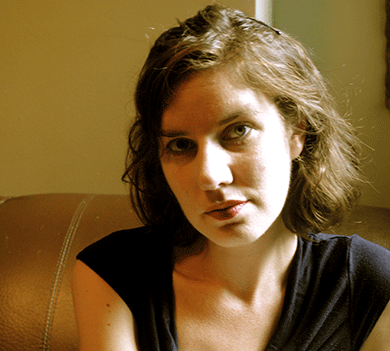In her debut collection of essays, Leslie Jamison investigates what it means to be an outsider. She interviews an incarcerated man and implicates herself as a voyeur, tries to contextualize the broken heart that led James Agee to write Let Us Now Praise Famous Men, examines the limits of a tourist’s understanding after being violently mugged in Nicaragua, and probes the psychological mysteries of Morgellons Disease (in an essay that originally ran in the September 2013 issue of Harper’s Magazine).
In a publishing industry dominated by the novel, it’s rare for a marginalized form like the essay collection to receive as much attention as The Empathy Exams has, and it’s rarer still when it’s a young author’s first collection. Jamison and I talked about her book at a hotel bar in Seattle, then corresponded about empathy in craft and in life, tragedy and trust, and their functions in fictional and nonfiction narratives.
1. Your essays consistently demand readers’ participation by trusting them to make logical leaps with you. What advantages does an active readership give an essayist? And when is it important to let the reader make the connections?
Trust always matters, but it especially matters when you’re writing about pain. You’re trusting your readers with the story of something that hurt you — or something that hurt someone else — so you also trust them to follow, to push back, to connect. Trust keeps preaching at bay: juxtaposition and subjective confession are alternatives to polemic.
When I wrote “Indigenous to the Hood,” my essay on the Los Angeles Gang Tour, I didn’t want to issue a verdict on the tour, I only wanted to dissect all the ways I’d felt uncomfortable when I was taking it. I wanted to bring my readers into the heightened pulse and nervous voice and sweaty palms of that discomfort. Assuming an active readership is also part of thinking about my essays as chapters in ongoing conversations, rather than entirely autonomous units of thought. They’re provocations, responses, and catalysts — necessarily incomplete, open to the responses of other minds. They can’t and don’t hold everything. There is so much they inevitably leave out; I want readers to be thinking about those gaps as much as they think about what they find.
A few months after I wrote “Lost Boys,” my essay about the West Memphis Three, I got to see Jason Baldwin speak. This was shortly after he was released from prison, having served almost twenty years for a crime he’d essentially been acquitted of. I stood up to tell him how much I admired his capacity for forgiveness — I was thinking of his seemingly intuitive ability to forgive the people who’d assumed his guilt — and I asked him where that forgiveness had come from. I was thinking about the stuff I’m always thinking about: webs of empathy, forays of imagination, all the systems by which we inhabit the minds of others. But Baldwin said something quite different, and much simpler: his faith in Christ.
His response made me think about how many things my essay had missed: Christian faith had supported Baldwin’s entire experience of incarceration but was entirely absent from my account of his experience of incarceration — which was only ever an account of my experience of his experience of incarceration anyway. The journalist’s story about her subject will always be different than her subject’s story of himself. Baldwin’s assertion of faith made me aware of what I already knew about essays, and still know about essays, but manage to forget each time I write one: they are shaped by absence as much as presence.
From “Grand Unified Theory of Female Pain”:
For long time I have hesitate to write a book on women, is how de Beauvoir starts one of the most famous books on women ever written. The subject is irritating, especially to women; and it is not new. Sometimes I feel like I’m, beating a dead wound. But I say: keep bleeding. Just write toward something beyond blood.
The wounded woman gets called a stereotype and sometimes she is. But sometimes she’s just true. I think the possibility of fetishizing pain is no reason to stop representing it. Pain that gets performed is still pain. Pain turned trite is still pain. I think the charges of cliché and performance offer our closed hearts too many alibis, and I want our hearts to be open. I just wrote that. I want out hearts to be open. I mean it.
2. In several pieces in The Empathy Exams, you explicitly remind your readers that you are writing an essay. The tradition of self-referential essays goes back to Montaigne, but why use it in the places you do? When does an essay need to call attention to itself?
This question also comes back to trust. I acknowledge the craft of my essays when I want to remind readers that everything is being constructed and arranged for them; that things are being connected and stitched together and left out; that this essay is a made thing — not a pane of glass — and they should trust me even more (ha!) because I’m saying that. Often, my confession of the essay — its dirty glass — is also an attempt to fight the delusion that I’ve been able to fully access someone else’s experience: Nothing human is alien to me is what the book’s epigraph says (and also a tattoo on my arm) but the truth is — things remain alien. Inevitably. Insolubly. In “Fog Count,” I describe quite a bit of the process of visiting Charlie Engle — an incarcerated long-distance runner — and part of that confession was driven by a deep need to acknowledge that I had only been a visitor to his confinement. I left him in prison so I could turn his imprisonment into art.
3. Your collection examines the way our culture sometimes receives individuals’ pain with apathy, or by dismissing it as melodramatic and whiny. How do you avoid the tropes of self-pity when writing about personal wounds?
At one point, when I’m writing about James Agee, I say, “It doesn’t seem right to say Agee risked sentimentality. Better to say he could smell it from a mile off and clawed his way into it anyway.” I’ve been inspired by that fearlessness. Often I talk directly about the specter of melodrama — the varieties of shame it can produce — rather than pretending it isn’t in the room. I want to fight whatever voice in us feels automatically self-conscious at the notion of discussing our pain.
I think self-pity gets destructive (“whiny”) when it produces tunnel vision, when it makes you forget the lives of others because you’re so focused on your own. My hope is that the structure of the book can fight that tunnel vision by twining together so many lives — my own among them but only one of them, just part of a chorus.
4. Essays in The Empathy Exams vary in approach from critical to personal to journalistic, with the linked essays “Pain Tours (I)” and “Pain Tours (II)” employing elements of each. How do you determine which approach is best?
I’d characterize the collection as a refusal to choose between these approaches — criticism, confession, journalism. This refusal feels less like determination and more like surrender: I seek the energy in every story, and I do whatever it takes to bring that energy onto the page, whether that involves personal narrative or critical analysis or getting on a plane or a train or a subway and doing some reporting; often it means letting all these kinds of inquiry bleed into one messy offering.
When I visited Charlie in prison, I was doing some version of reporting, but in the essay I’m also peeling away the skin of journalistic objectivity to show raw flesh underneath: all my anxiety about asking the right questions, following the prison rules, abandoning Charlie to return to my own freedom. I want to show what the reporting found, but I also want to show how it happened, and what kind of emotional web it emerged from. Personal experience is often a root structure beneath other kinds of inquiry: driving the questions, the curiosity, the encounters. Confessing to that root structure isn’t just a way of confessing bias — I’m a subjective observer — but a way of connecting to investments, of saying, This was the engine; this got me aching, and then later, This hurt to discover.
5. Essay collections map not only the consciousness of the author but also a personal narrative. How did the experience of crafting a narrative in this essay collection differ from the process of writing your novel, The Gin Closet?
As I was arranging the essays in the collection, I wanted to offer movement between introspection and outward vision — the outward gazes entailed by literary and cultural criticism, travel, journalism. Both the opening and closing essays contain highly confessional moments, and I mean those confessions as affirmations of presence: Reader, I’m joining you on this journey. In this sense, I offer my own story in order to offer myself as companion for the encountering of others’ stories.
Perhaps, then, the most enduring relationship of the book is the one that gets forged between the reader and my narrative voice — this voice that’s alternately confessing and reporting, showing wounds and wielding stethoscopes. I can’t think of any journey — including the journey across the arc of a book — without thinking of the relationships it creates or implies. My novel, The Gin Closet, is centered on the relationship between two women, and this relationship also begins with a journey: a road trip across the desert. The novel’s narrative is plumbing resonances between their lives — moving back and forth in time to find these echoes — and also follows the intimacy that grows between them, the ways they try to heal each other’s damage. This essay collection is much less dyadic: its relationships are much more multiple and kaleidoscopic: the relationship between two lovers; between journalist and subject; between patients with the same illness; between runners running the same impossible distance; between women who are strangers but part of the same zeitgeist.
If The Gin Closet is about feeling trapped inside pain — exploring pain as a kind of claustrophobia — then this book returns to that confinement by fighting it, struggling against that isolation in pretty much every way it can.
6. Do you think your book offers a defense of empathy? Does it find anything dangerous or troubling about empathy?
Yes, and yes, and yes. All three. I’m interested in everything that might be flawed or messy about empathy — how imagining other lives can constitute a kind of tyranny, or artificially absolve our sense of guilt or responsibility; how feeling empathy can make us feel we’ve done something good when we actually haven’t. Zizek talks about how “feeling good” has become a kind of commodity we purchase for ourselves when we buy socially responsible products; there’s some version of this inoculation logic — or danger — that’s possible with empathy as well: we start to like the feeling of feeling bad for others; it can make us feel good about ourselves. So there’s a lot of danger attached to empathy: it might be self-serving or self-absorbed; it might lead our moral reasoning astray, or supplant moral reasoning entirely. (See this fantastic piece by Paul Bloom in The New Yorker.) But do I want to defend it, despite acknowledging this mess? More like: I want to defend it by acknowledging this mess. Saying: Yes. Of course. But yet. Anyway.






